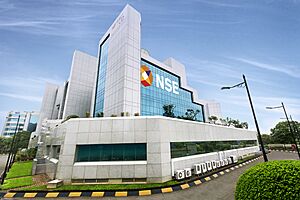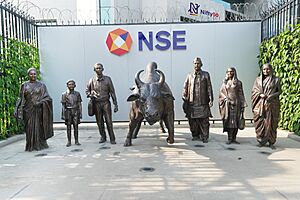National Stock Exchange of India facts for kids
| National Stock Exchange of India Limited | |
|---|---|
Quick facts for kids National Stock Exchange of India (NSE) logo.svg |
|
| IT7A2275 copy (cropped).jpg | |
| Type | Stock exchange |
| Location | [[Mumbai, Maharashtra]], India |
| Founded | 27 November 1992 |
| Owner | Various domestic and global financial institutions, public and privately-owned entities, and individuals |
| Key people | Ashishkumar Chauhan (MD & CEO) |
| Currency | Indian rupee (₹) |
| No. of listings | 2,671 (December 2024) |
| MarketCap | ₹438 lakh crore (US$7.4 trillion) (December 2024) |
| Indexes |
|

The National Stock Exchange of India, or NSE, is a major stock market located in Mumbai, India. It is one of the largest stock exchanges in the world. Here, companies can raise money, and people can buy and sell parts of those companies.
Many different banks and insurance companies own parts of the NSE. It is also a global leader in trading special financial agreements called 'derivatives.'
Contents
History of the NSE
The National Stock Exchange started in 1992. Its goal was to make the Indian stock markets more open and fair. The Indian government helped set it up.
Before NSE, only a few brokers could trade. NSE changed this, allowing anyone qualified to trade. This made the market more accessible.
Early Operations
NSE began its trading activities on June 30, 1994. It first handled a market for government and company loans. Then, on November 3, 1994, it started trading company shares.
It was the first exchange in India to use a fully electronic trading system. This made buying and selling much faster and easier. Within a year, NSE's daily trading volume was higher than the older Bombay Stock Exchange.
New Trading Products
NSE started trading 'derivatives' on June 12, 2000. These are special contracts based on the future value of stocks or other assets. In August 2008, it added trading for currency derivatives. These are contracts based on how currency exchange rates might change.
In 2012, NSE created a platform called NSE EMERGE. This platform helps smaller companies and new businesses in India get listed and raise money. In May 2013, NSE launched India's first trading platform just for debt products.
In June 2017, NSE opened the NSE International Exchange (NSE IX). This is an international stock exchange located in GIFT City, India. In 2023, NSE also launched a Social Stock Exchange. This helps non-profit groups and other social businesses raise money from the public.
How Trading Works
Companies Listed on NSE
As of December 2024, there are 2,671 companies listed on the NSE. Most of these are on the main trading board. About 587 companies are listed on the NSE EMERGE platform for smaller businesses.
The total value of all companies listed on NSE was very high in December 2024. This value is called 'market capitalization.'
Many different types of investment funds are also traded on NSE. These include Exchange-Traded Funds (ETFs). As of January 2025, over 110 million people have registered to invest on the NSE.
NSE's Main Indexes
NSE Indices manages the different stock market indexes for NSE. An index is like a group of stocks that shows how a part of the market is doing. The most famous index is the NIFTY 50. It started on April 22, 1996. The NIFTY 50 tracks the performance of 50 large Indian companies.
Trading Derivatives
The NSE allows trading of futures and options contracts. These are types of derivatives. They let investors bet on the future price of an index or a single stock.
In 2012, NSE started offering derivative contracts on the FTSE 100 index. This is a major stock index from the UK. In 2013, NSE also partnered with Japan Exchange Group. This allowed the NIFTY 50 index futures to be traded on the Osaka Securities Exchange in Japan.
NSE's Leadership
Who Owns NSE
Many different groups own parts of the NSE. These include large Indian government-owned investors like Life Insurance Corporation and State Bank of India. Private investment companies also own shares in NSE.
Leaders of NSE
The NSE has had several important leaders over the years. These are the Managing Directors (MDs) and Chief Executive Officers (CEOs):
| No. | Name | Term of office | Ref. | ||
|---|---|---|---|---|---|
| Assumed office | Left office | Time in office | |||
| 1 | Ravi Narain | 2000 | 1 April 2013 | 12 years, 151 days | |
| 2 | Chitra Ramkrishna | 1 April 2013 | 2 December 2016 | 3 years, 245 days | |
| 3 | Vikram Limaye | 6 February 2017 | 16 July 2022 | 5 years, 160 days | |
| 4 | Ashish Chauhan | 18 July 2022 | Incumbent | 3 years, 159 days | |
NSE's Other Companies
NSE has several subsidiary companies. These are companies that NSE owns and controls. They help with different parts of the stock market. Some examples include:
- NSE Indices Limited: This company manages the stock market indexes.
- NSE International Exchange (NSE IX): This is the international trading platform.
- NSE Clearing Limited: This company helps make sure trades are completed correctly.
- NSE Academy Limited: This company focuses on teaching people about finance.
Learning About Finance
NSE works with many universities to offer courses in finance. These include MBA and BBA programs. They help students learn about investing and managing money.
NSE also has a special software called NSE Learn to Trade (NLT). This software lets students practice trading in a fake market. It's very similar to what real traders use. This helps students learn how the market works without risking real money.
NSE also offers online exams and certifications. These are called Certification in Financial Markets (NCFM) programs. They help people get certified in different areas of finance. There are 46 different courses available, from beginner to advanced levels. NSE Academy Limited was set up to help with all these educational programs.
See also
 In Spanish: Bolsa Nacional de Valores de India para niños
In Spanish: Bolsa Nacional de Valores de India para niños
- List of companies listed on the National Stock Exchange of India
- Economy of India
- List of stock exchanges
- Bombay Stock Exchange
- Securities and Exchange Board of India


